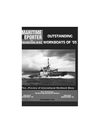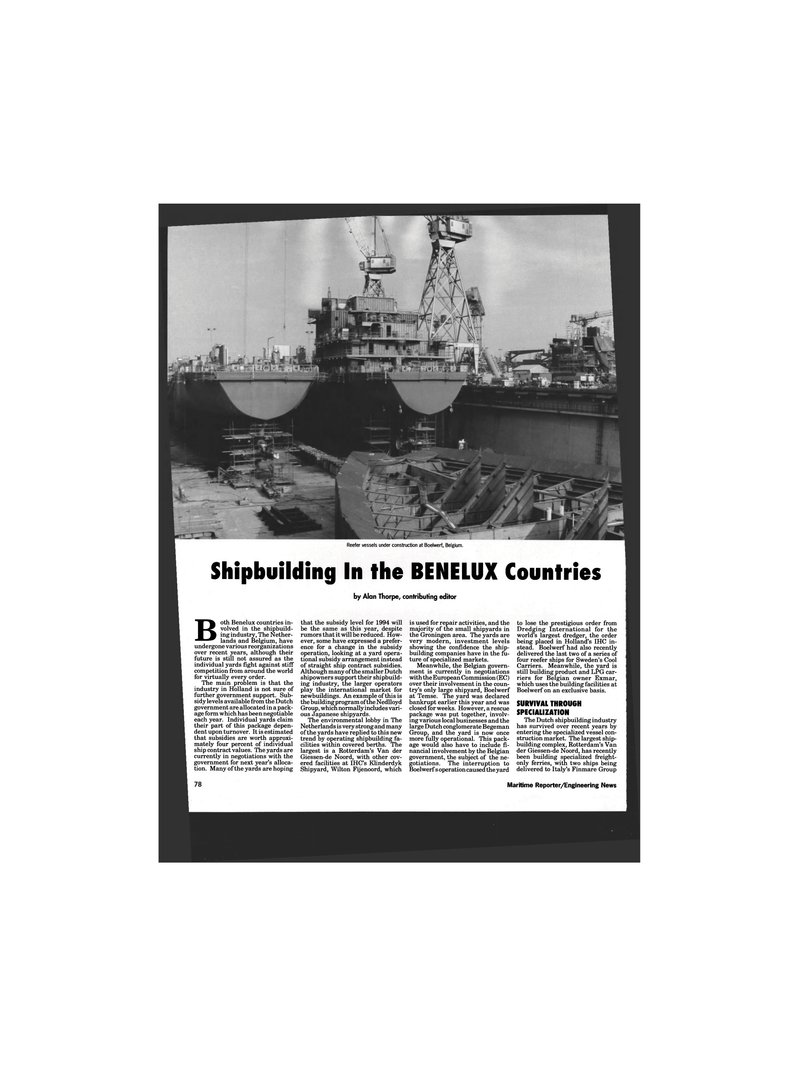
Page 76: of Maritime Reporter Magazine (November 1993)
Read this page in Pdf, Flash or Html5 edition of November 1993 Maritime Reporter Magazine
Reefer vessels under construction at Boelwerf, Belgium.
Shipbuilding In the BENELUX Countries by Alan Thorpe, contributing editor
Both Benelux countries in-volved in the shipbuild-ing industry, The Nether-lands and Belgium, have undergone various reorganizations over recent years, although their future is still not assured as the individual yards fight against stiff competition from around the world for virtually every order.
The main problem is that the industry in Holland is not sure of further government support. Sub- sidy levels available from the Dutch government are allocated in a pack- age form which has been negotiable each year. Individual yards claim their part of this package depen- dent upon turnover. It is estimated that subsidies are worth approxi- mately four percent of individual ship contract values. The yards are currently in negotiations with the government for next year's alloca- tion. Many of the yards are hoping that the subsidy level for 1994 will be the same as this year, despite rumors that it will be reduced. How- ever, some have expressed a prefer- ence for a change in the subsidy operation, looking at a yard opera- tional subsidy arrangement instead of straight ship contract subsidies.
Although many of the smaller Dutch shipowners support their shipbuild- ing industry, the larger operators play the international market for newbuildings. An example of this is the building program of the Nedlloyd
Group, which normally includes vari- ous Japanese shipyards.
The environmental lobby in The
Netherlands is very strong and many of the yards have replied to this new trend by operating shipbuilding fa- cilities within covered berths. The largest is a Rotterdam's Van der
Giessen-de Noord, with other cov- ered facilities at IHC's Klinderdyk
Shipyard, Wilton Fijenoord, which is used for repair activities, and the majority of the small shipyards in the Groningen area. The yards are very modern, investment levels showing the confidence the ship- building companies have in the fu- ture of specialized markets.
Meanwhile, the Belgian govern- ment is currently in negotiations with the European Commission (EC) over their involvement in the coun- try's only large shipyard, Boelwerf at Temse. The yard was declared bankrupt earlier this year and was closed for weeks. However, a rescue package was put together, involv- ing various local businesses and the large Dutch conglomerate Begeman
Group, and the yard is now once more fully operational. This pack- age would also have to include fi- nancial involvement by the Belgian government, the subject of the ne- gotiations. The interruption to
Boelwerf s operation caused the yard to lose the prestigious order from
Dredging International for the world's largest dredger, the order being placed in Holland's IHC in- stead. Boelwerf had also recently delivered the last two of a series of four reefer ships for Sweden's Cool
Carriers. Meanwhile, the yard is still building product and LPG car- riers for Belgian owner Exmar, which uses the building facilities at
Boelwerf on an exclusive basis.
SURVIVAL THROUGH
SPECIALIZATION
The Dutch shipbuilding industry has survived over recent years by entering the specialized vessel con- struction market. The largest ship- building complex, Rotterdam's Van der Giessen-de Noord, has recently been building specialized freight- only ferries, with two ships being delivered to Italy's Finmare Group 78 Maritime Reporter/Engineering News

 75
75

 77
77
